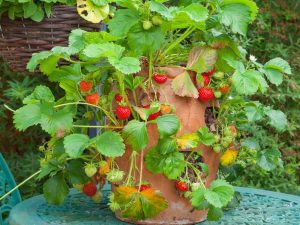Last Updated on February 23, 2024 by teamobn

Space-saving ideas are always welcome, especially if you live in a tight spot. This leaves room for something else or makes an area less cluttered. If you’re constantly on the lookout for tips that will help you make good use of space, this one’s for you.

This staircase planter is a great vertical gardening idea. It’s a simple project, one that you can easily do in one day. If you’re an inexperienced woodworker, ask for help. It’s a fun and worthwhile project to do.

Building a Staircase Vertical Planter
Contents
Materials
- 2 – Stair Risers
- 5 – Planter Boxes
- 1 – 2″x4″x12′ Pressure Treated Board
- 4 – 3.5″ 5/16 Hex Bolts
- 4 – 5/16 Nuts
- 8 – 5/16 Washers
- 20 Screws (and matching size Washers)
- 8 additional Screws
Tools
- Drill
- Measuring Tape
- Circular Saw
Instructions
Step 1: Prepare the Base
Start by using the circular saw to cut the 2″x4″x12′ pressure-treated board into four equal pieces; these will serve as the base for your staircase vertical planter. Ensure the cuts are straight and even for a stable foundation.
Step 2: Assemble the Base Frame
Lay out the cut pieces to form a rectangular base frame. Use the drill and screws to secure the corners together, making sure the base is solid and square. This frame will support the stair risers and planter boxes.
Step 3: Attach the Stair Risers
Position the stair risers at both ends of the base frame. Ensure they are aligned properly, with equal distances from the ends and sides of the base frame for stability. Use the drill and screws to attach the risers securely to the base frame. The stair risers will act as the backbone of your staircase vertical planter, providing support for the planter boxes.
Step 4: Secure Planter Boxes
Place the first planter box on the lowest step of the stair risers. Use the drill and screws to secure the planter box to the riser, ensuring it is firmly in place. Repeat this process for the remaining planter boxes, working your way up the staircase risers. Ensure each box is level and securely attached.
Step 5: Reinforce the Structure
For added stability, use the 3.5″ 5/16 hex bolts, nuts, and washers to reinforce the points where the stair risers meet the base frame. Drill holes through the risers and base frame, insert the bolts, and tighten the nuts with washers on both sides. This step ensures your staircase vertical planter can support the weight of the soil and plants.
Step 6: Final Touches
Inspect your staircase vertical planter for any sharp edges or loose connections. If necessary, tighten any loose screws and sand down sharp edges for safety. Your staircase vertical planter is now ready for painting or staining if desired, followed by the addition of soil and plants.
Step 7: Planting
Fill each planter box with high-quality potting soil and plant your choice of flowers, herbs, or vegetables. Be mindful of the sunlight and water requirements of your plants to ensure a thriving staircase vertical planter.
Advantages of Vertical Gardening
Vertical gardening is an innovative approach to cultivating plants that not only saves space but also offers a plethora of benefits for gardeners and the environment alike. This method is particularly advantageous for those with limited ground space, making it perfect for urban dwellers. By integrating a staircase vertical planter into your home or garden, you can transform any small or underutilized area into a lush, vertical garden.
Below are the key advantages of adopting vertical gardening, especially when utilizing a staircase vertical planter.
Enhanced Aesthetic Appeal
A staircase vertical planter adds a striking visual element to any space. It can turn bland walls or empty corners into vibrant displays of greenery and flowers. The vertical arrangement allows for a creative showcase of plants, enhancing the overall aesthetic appeal of your home or garden. Moreover, a well-designed staircase planter serves as a living piece of art, bringing a touch of nature indoors or making outdoor spaces more inviting.
Space Efficiency
One of the most significant advantages of vertical gardening, particularly with a staircase vertical planter, is its space-saving nature. This method makes the most out of vertical spaces, allowing you to grow a variety of plants without the need for a traditional, expansive garden plot. It’s an ideal solution for those living in apartments, condos, or homes with limited outdoor space, enabling them to cultivate a thriving garden in a compact area.
Accessibility and Ease of Maintenance
Staircase vertical planters bring plants to a more accessible level, which can be especially beneficial for individuals with mobility issues or those who find bending and kneeling uncomfortable.
This accessibility makes planting, pruning, and harvesting easier and more enjoyable. Furthermore, vertical gardens can simplify certain maintenance tasks, such as pest monitoring and disease control, due to the plants’ elevated positioning.
Improved Air Quality
Incorporating plants into your living space with a staircase vertical planter can significantly improve indoor air quality. Plants filter and purify the air, removing harmful toxins and producing oxygen. A vertical garden inside your home beautifies the space and contributes to a healthier living environment by purifying the air you breathe.
Microclimate Control
A staircase vertical planter can help create a beneficial microclimate in your garden or home. Plants in vertical arrangements can provide shade and reduce ambient temperatures in their immediate vicinity. This natural cooling effect can be particularly advantageous in urban areas, where concrete and asphalt tend to increase temperatures. Additionally, vertical gardens can act as windbreaks and noise buffers, creating a more serene and comfortable environment.
Biodiversity and Habitat Creation
Vertical gardens, including those utilizing staircase planters, can support various plant species, promoting biodiversity. By selecting various plants, you can attract beneficial insects, birds, and other wildlife, creating a small ecosystem that supports local biodiversity. This aspect is particularly important in urban areas with limited green spaces.
The benefits of vertical gardening, especially through a staircase vertical planter, are manifold. This gardening approach optimizes space, enhances aesthetic appeal, and contributes to environmental sustainability and personal well-being.
Click on any image to start the lightbox display. Use your Esc key to close the lightbox.









Irrigation Solutions for Staircase Planters
Irrigation is a critical component of maintaining a healthy and thriving garden, especially when it comes to staircase vertical planters. These unique gardening solutions offer a fantastic way to maximize space and add greenery to your home, but they also require a thoughtful approach to watering.
Below, we explore various irrigation solutions that are ideal for staircase vertical planters, ensuring your plants receive the right amount of water without the hassle.
Gravity-Based Drip Systems
Gravity-based drip irrigation systems offer an innovative and eco-friendly approach to watering staircase vertical planters, making them an ideal choice for gardeners seeking simplicity and efficiency.
This method capitalizes on the natural force of gravity to distribute water from the top of the staircase vertical planter down to each plant in the sequence. The beauty of this system lies in its simplicity and effectiveness, providing a steady supply of moisture to every plant without the necessity for intricate plumbing or electrical installations.
The Mechanism Behind Gravity-Based Drip Systems
The core principle of gravity-based drip irrigation for staircase vertical planters is straightforward. A water reservoir is placed at the highest point of the planter setup. From this reservoir, water is funneled through a network of narrow tubes that lead to each planter in the staircase setup.
Small holes or emitters along these tubes allow water to drip out slowly, directly reaching the root zone of each plant. This slow-release method ensures that water is absorbed efficiently by the soil, minimizing wastage through runoff or evaporation.
Advantages of Gravity-Based Drip Systems in Staircase Vertical Planters
- Water Efficiency: By delivering water directly to the base of each plant, gravity-based drip systems for staircase vertical planters significantly reduce water waste. This precision watering is better for the environment and ensures that plants receive the exact amount of water they need to thrive.
- Simplicity of Installation: Setting up a gravity-based drip system for a staircase vertical planter does not require professional help or specialized tools. One can install the system with basic DIY skills, making it an accessible option for gardeners of all levels.
- Low Maintenance: Once installed, gravity-based drip irrigation systems require minimal upkeep. The simplicity of the design means fewer parts can break or malfunction, ensuring a long-lasting solution for watering staircase vertical planters.
- Cost-Effectiveness: Compared to other irrigation methods that may require pumps, timers, or electrical connections, gravity-based systems are a cost-effective solution. Their operation does not incur additional energy costs, making them economical in the long term.
- Flexibility and Scalability: Whether your staircase vertical planter is small or expansive, gravity-based drip systems can be easily adapted to meet the specific needs of your garden. Additional lines can be added as your garden grows, and the flow rate can be adjusted to accommodate the water requirements of different plants.
Implementing Gravity-Based Drip Systems for Staircase Vertical Planters
To maximize the benefits of a gravity-based drip system in your staircase vertical planter, consider the following tips:
- Ensure the water reservoir is placed high enough to create sufficient pressure for water to flow through the drip lines.
- Use a filter at the reservoir outlet to prevent clogging of the drip emitters.
- Regularly check the emitters for blockages to maintain a consistent water flow.
- Adjust the placement of drip emitters to coincide with the root zones of your plants for efficient water usage.
Automated Drip Irrigation Systems
Automated drip irrigation systems represent the pinnacle of convenience and efficiency for watering staircase vertical planters. These advanced systems offer a tailored solution to meet the specific hydration requirements of each plant within the unique structure of a staircase vertical planter.
By integrating technology with gardening, automated drip irrigation systems ensure that plants receive exactly the right amount of water at the right time, maximizing growth and health while minimizing water waste and effort on the part of the gardener.
Customization and Precision
The beauty of automated drip irrigation systems for staircase vertical planters lies in their ability to be fully customized. Adjustable drip emitters can be calibrated to release water in precise quantities, catering to the individual water needs of different plants.
This level of precision is invaluable, especially in staircase vertical planters where plant types with varying water requirements may be closely arranged. Furthermore, the integration of timers allows gardeners to set specific watering schedules, ensuring that plants are watered at the most effective times of day, even in the gardener’s absence.
Time and Water Efficiency
One of the most significant advantages of utilizing automated drip irrigation systems in staircase vertical planters is the remarkable savings in time and water. These systems eliminate the need for manual watering, allowing gardeners time to focus on other aspects of plant care or leisure.
Additionally, by delivering water directly to the root zone of each plant, automated systems reduce evaporation and runoff, making them an environmentally friendly choice. This efficiency is especially crucial during periods of drought or water restrictions, ensuring that staircase vertical planters remain lush and thriving without excessive water use.
Enhancing Plant Health and Growth
Automated drip irrigation systems contribute significantly to the health and growth of plants in staircase vertical planters. By providing a consistent and adequate water supply, plants are less likely to experience stress from under or overwatering.
This steady water availability promotes stronger root development and improved nutrient uptake, leading to healthier plants and more abundant blooms or yields. Moreover, the reduced moisture on plant leaves and stems can help prevent the onset of fungal diseases, which are more common with overhead watering methods.
Easy Installation and Maintenance
Despite their advanced capabilities, automated drip irrigation systems for staircase vertical planters are surprisingly easy to install and maintain. Many systems come with user-friendly instructions and can be set up with basic tools.
Maintenance typically involves periodic checks to ensure that drip emitters function correctly and that the timer settings remain appropriate for the plants’ changing needs through different seasons or growth stages.
Integration with Smart Home Systems
For those who embrace technology, some automated drip irrigation systems can be integrated with smart home systems. This allows for remote monitoring and control of the watering schedule through a smartphone or computer.
Such connectivity offers the ultimate convenience, enabling gardeners to adjust their staircase vertical planter’s irrigation system from anywhere, ensuring optimal plant care even when away from home.
Mulching and Moisture Retention
Mulching is a critical strategy for optimizing moisture retention in staircase vertical planters, playing a pivotal role in water conservation and plant health. Applying a protective layer of mulch to the soil surface of staircase vertical planters brings many benefits, from reducing the frequency of watering to fostering a more vibrant and resilient plant ecosystem.
Let’s delve deeper into how mulching can be effectively utilized to enhance the moisture retention capabilities of your staircase vertical planter.
Enhancing Moisture Retention
The primary benefit of incorporating mulch into your staircase vertical planter is its remarkable ability to retain soil moisture. Mulch acts as a barrier between the soil and the air, significantly reducing evaporation rates.
This means that water applied to your staircase vertical planter, whether through rainfall or irrigation, will remain in the soil for longer periods, directly accessible to the plant roots. In the context of staircase vertical planters, where soil depth may be limited and exposure to wind and sun can increase evaporation, mulch becomes an indispensable ally in maintaining optimal moisture levels.
Organic Mulch Options
Selecting the right type of mulch is crucial for the success of your staircase vertical planter. Organic mulches, such as straw, bark chips, or coconut coir, are particularly beneficial. These materials not only help in retaining moisture but also gradually break down over time, enriching the soil with organic matter. This process improves soil structure, enhances nutrient availability, and fosters beneficial microbial activity, contributing to a healthier soil ecosystem within your staircase vertical planter.
Temperature Regulation
Mulch serves an important role in regulating soil temperature within staircase vertical planters. By insulating the soil, mulch can protect plant roots from extreme temperature fluctuations, keeping the soil cooler on hot days and warmer during cooler periods. This stability is crucial for the healthy growth of plants in staircase vertical planters, ensuring that roots remain in an environment conducive to nutrient uptake and growth.
Weed Suppression
Another significant advantage of mulching your staircase vertical planter is weed suppression. A thick layer of mulch can effectively block light from reaching weed seeds in the soil, significantly reducing weed germination and growth. This means less competition for water and nutrients, allowing your plants to thrive without the added stress of weed infestation.
Water Conservation and Aesthetic Appeal
Incorporating mulch into your staircase vertical planter is a key strategy in water conservation. By minimizing evaporation and reducing the need for frequent watering, mulch helps conserve this vital resource. Additionally, mulch can add a finished look to your staircase vertical planter, enhancing its aesthetic appeal with various textures and colors offered by different mulch materials.
Implementation Tips
When applying mulch to your staircase vertical planter, aim for a layer approximately 2 to 3 inches thick. Be careful to leave some space around the base of each plant to prevent moisture buildup directly against the stems, which could lead to rot. Periodically check the mulch layer and replenish it as needed to maintain its benefits throughout the growing season.
A range of irrigation solutions can be tailored to the specific needs of your staircase vertical planter. Whether you opt for a simple gravity-based system, invest in automated irrigation, or prefer the hands-on approach of manual watering, ensuring your plants receive adequate moisture is key to a thriving vertical garden.
Conclusion
Constructing a staircase vertical planter is a rewarding project that optimizes limited gardening space and adds a unique architectural element to your outdoor or indoor living area. This versatile gardening solution is perfect for those looking to combine functionality with style, ensuring your plants thrive in a space-saving and visually appealing setup.
For more gardening methods to save space, check out our compact gardening post next!








